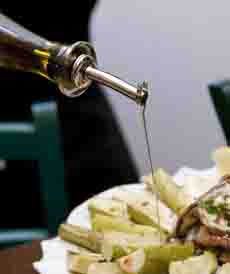TIP OF THE DAY: Homemade Infused Oils
|
You may see a proliferation of infused olive oils at the market. But you might want to infuse your own: Speaking of easy: Infused oils are easy to make. The technique we describe below takes only minutes, not weeks of infusing. WHEN TO USE INFUSED OILS Infused oils can add a rich, complex boost of flavor and aroma to nearly anything you prepare. We use them to: |
|
|
|
WHAT FLAVORS TO INFUSE Most of the oils in the market are infused with herbs, citrus or garlic. Basil and rosemary are the most popular herbs, but also consider using cilantro, dill, oregano, parsley or thyme. For citrus: blood orange, grapefruit, lemon, lime, mandarin or exotics (calamondin, kaffir lime). For spices, just look on the spice shelf and find what piques your interest. How about chile, cinnamon, coriander, cumin, dill, fennel, nutmeg or star anise? For aromatics: garlic, ginger, lemongrass or scallions. How about nuts: almonds, hazelnuts, pecans, pistachios or walnuts? |
||
 Add flavor to grilled vegetables. Photo courtesy Flavor-Your-Life.com. |
QUICK-INFUSED OIL
While many infused oils are made by soaking herbs in oil for anywhere from a few days to a few weeks, a quick and easy infused oil can be make on the stove top in minutes. Since you’re adding flavor, there’s no need to splurge on an expensive oil. If you’re infusing olive oil, use one that has mild flavor—not too peppery or fruity (unless you want those flavors in the final product). Or, pick a neutral cooking oil like canola (the different types of cooking oils). 2a. FOR HERBS: Add three sprigs of fresh herbs and a lightly smashed clove of garlic. Let the herbs cook in the pan until they’re just starting to brown, but not burn. |
|
|
2b. FOR SPICES: Cook until the oil just starts to bubble. 2c. FOR NUTS: Use nuts that are raw and unsalted. Cook until they’re just starting to brown. Cooking any of these on the lowest heat possible will give the oil time to pull out the flavors while not burning. 3. COOL and strain the oil with a fine-mesh strainer or cheesecloth. Then funnel the oil into a glass bottle with a tight-fitting cap. Store in the fridge for up to 1 month. 4. REMOVE the oil from the fridge 20 minutes before using, to bring it to room temperature. Or, use it as soon as it’s made. |
||



